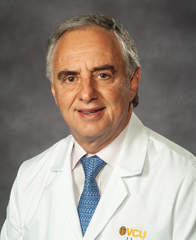Interventions for Lower Extremity PAD
 Dr. Mark Levy
Dr. Mark Levy
 Dr. Luis Guzman
Dr. Luis Guzman
Peripheral artery disease (PAD) is often called a “silent killer.” Often, individuals are not aware they have the condition until it has significantly progressed.
“People are walking around all the time with blockages in their legs,” said Dr. Mark Levy, chair of the Division of Vascular Surgery and the H. M. Lee Professorship in Vascular Surgery. “When it’s symptomatic, it’s usually leg cramping or gripping when walking. If the blockage is more severe, then it can cause pain in the feet at rest, which is known as ischemic rest pain. Sometimes the condition can be asymptomatic until the patient develops gangrene, due to lack of circulation.”
The blockages are caused by atherosclerosis, or the buildup of plaque in arteries. Risk factors for developing PAD include smoking, diabetes, hypertension and high cholesterol.
In addition, “the vast majority of patients with PAD will have coronary artery disease,” said Dr. Luis Guzman, medical director of Pauley’s Cardiac Catheterization Laboratory. “There is a significant interaction between the two processes. When a coronary artery disease patient has both conditions, their risk of mortality increases sevenfold. That’s why the prevention and the treatment of this is very important.”
Pauley’s vascular and cardiology teams often collaborate on the treatment of patients. Early treatments can include diet and other lifestyle changes or medications. The first step is a 3D cardiovascular evaluation using state-of-the-art ultrasound imaging and noninvasive imaging tests like magnetic resonance angiograms or computed tomography, or CT, scans. The exams are available at Pauley’s downtown Richmond, Stony Point, Prince George and Colonial Heights locations.
“There is a significant interaction between the two processes. When a coronary artery disease patient has both conditions, their risk of mortality increases sevenfold. That’s why the prevention and the treatment of this is very important.”
For more advanced cases of PAD, Pauley’s vascular surgeons and interventional cardiologists offer various procedures:
Minimally invasive, catheter-based treatment. Angioplasty and stent: A catheter is inserted into the patient’s femoral artery in the groin. The doctor then directs the catheter through the body to the location of the blockage. A small balloon is then inflated to open the artery, which is followed by the placement of a mesh stent.
During an atherectomy, the physician uses a catheter with a blade on one end to shave off plaque that is hardened to the artery walls. Like angioplasty, this procedure is generally performed under local anesthesia, with patients leaving the hospital the same day or the next morning.
Lower extremity bypass surgery is recommended when patients have large blockages or are not good candidates for the minimally invasive, catheter-based procedures. In the procedure, the surgeon bypasses the blockage by creating a new path for blood flow by using a graft from one of the patient’s veins. The surgery requires general anesthesia and a hospital stay.
Pauley’s teams take care of some of the area’s most complex lower extremity PAD patients.
“We’ve been able to offer people limb-saving procedures in situations where other institutions can only offer amputations,” said Levy. Additionally, “we’ve had patients with severe blockages that require both open surgical bypass and angioplasty on two different areas of their leg. Since we have the region’s most modern hybrid suites, we’re able to take advantage of our facilities for the patient’s benefit, performing both the bypass and the angioplasty in one setting.”
About 80% of the surgical procedures for lower extremity PAD are scheduled, with the remaining 20% performed under emergency circumstances. The interventions have led to significantly improved mobility and quality of life for patients.
“Drs. Levy and Guzman are expert clinicians with decades of experience in treating patients with peripheral arterial disease. Combining a collaborative approach with state-of-the-art technologies, they and their colleagues offer some of the most advanced interventions in the region,” said Dr. Kenneth Ellenbogen.
The Pauley teams stay current on research that can benefit patients with PAD and have taken part in trials for new therapies aimed at increasing lower extremity circulation.
Whatever the necessary treatment, “we are patient-centered and safety-focused,” said Levy.
To set up a consultation, please contact the Pauley Heart Center at 1-800-762-6161.
The following Pauley physicians have expertise in treating lower extremity PAD:
- Dr. Francisco Albuquerque, Jr. • Vascular Surgery
- Dr. Jose Exaire • Interventional Cardiology
- Dr. Luis Guzman • Interventional Cardiology
- Dr. Robert Larson • Vascular Surgery
- Dr. Mark Levy • Vascular Surgery
Stroke Prevention via the Carotid Artery
Pauley’s vascular surgeons have extensive experience with the minimally invasive stenting of the carotid artery, which is found in the neck. The interventions are performed via catheter.
“Most are not emergency procedures but are performed promptly when patients are discovered to have a severe blockage in the carotid artery to their brain,” said Dr. Mark Levy. “Some of those patients have had ministroke or stroke symptoms; other patients are occasionally identified before they develop these life-threatening symptoms.”
Signs and symptoms for a stroke may include face drooping, blurred vision, difficulty with speech or a sudden weakness, often on one side of the body. Always call 911 in the event of a suspected stroke.
Did you know…
About 8.5 million people in the U.S. suffer from peripheral artery disease, according to the American Heart Association.
Back to Autumn-2018
Join our Pauley Consortium composed of patients, friends and advocates.

